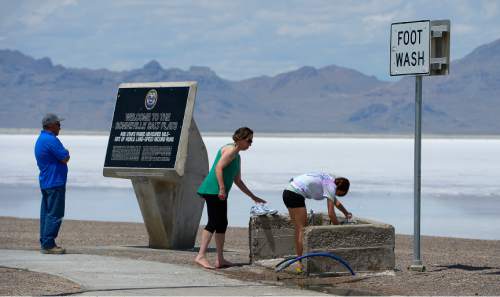This is an archived article that was published on sltrib.com in 2016, and information in the article may be outdated. It is provided only for personal research purposes and may not be reprinted.
For more than 80 years, the Bonneville Salt Flats have been about speed, only now it's about how fast they're disappearing.
The flats are running out of salt, and salt is what has made the surface both flat and hard, a combination that has made them home to the world's fastest land vehicles.
It's not a new problem. In fact, a nearby potash company has been pumping salt water on to the flats for almost 20 years to try and build a thicker layer. But, at best, it has slowed the decline. Both climate and the potash production have been named as culprits for the vanishing salt, but the evidence doesn't point to either as the clear source.
That has the flats' owner, the U.S. Bureau of Land Management, turning to the closest experts, geologists at the University of Utah, to figure out what is going on. That study is expected to take a couple more years.
Not fast enough, say the people who hold races on the flats at what is referred to as Bonneville Speedway. Racers stage a handful of events over a normal summer, but they often have had to cancel them recently because the salt layer is dangerously thin for crossing at hundreds of miles per hour.
The racers fear that two more years of study could kill the flats completely as a speed venue. They want that potash company to start pumping even more salt water, but the company says it doesn't have the water to do that.
More importantly, there isn't solid evidence it will stop the decline.
Bonneville's place in motor history began in 1933, when a Brit named Malcolm Campbell topped 300 mph in his Rolls Royce-powered roadster called the "Blue Bird." And it's been almost 50 years since Gary Gabelich piloted his "Blue Flame" – essentially a horizontal rocket – more than 633 miles per hour across the flats in 1970. Nothing has crossed the Bonneville salt faster since then.
More recent land speed records, including the first supersonic record, happened on the alkali flats of the Black Rock Desert in northwest Nevada. (Would Bonneville races ever migrate there? They may have to share with another event, the annual Burning Man Festival, which also uniquely benefits from flatness. Talk about culture clash.)
Whatever is learned from research, the racers have to accept this about Bonneville: Racing is not the driving factor in managing the flats' future, if the situation can be managed at all.
In the meantime, there is hope this year's racing events may still take place. The key is getting enough evaporation so the surface is plenty hard by mid-summer.
Patience, speed freaks.



